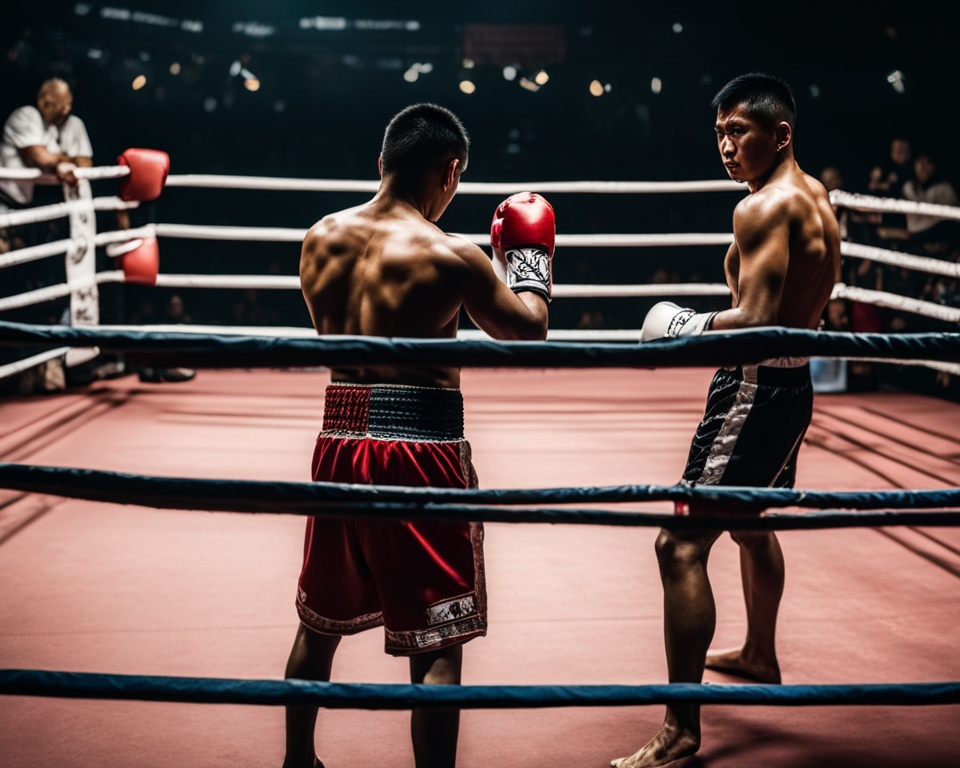
Muay Thai is a thrilling combat sport known for its skill, power, and strategy. It’s important for both experienced fighters and newcomers to know the rules. This guide will cover the key rules of Muay Thai, including the ring setup, scoring, and what moves are banned.
This article will explore the basics of Muay Thai, like striking and clinching. It aims to give you a clear understanding of the rules for Muay Thai fights. Whether you’re stepping into your first fight or just want to learn more, this guide is perfect for you.
Read more interesting information at ::102aoki
What are Muay Thai Rules?
Muay Thai, also known as the “art of eight limbs,” comes from Thailand. It’s a combat sport with its own set of rules. These rules cover techniques, scoring, and how fighters should act during a match. It’s important for fighters and fans to know these rules.
Muay Thai uses eight points of contact for striking: fists, elbows, knees, and shins. Fighters can hit their opponents with these eight limbs. This makes Muay Thai a unique and effective combat sport.
The rules of Muay Thai include details on the ring size, scoring, and allowed techniques. These rules help keep fighters safe, maintain the sport’s integrity, and ensure fair competition.
| Key Muay Thai Rules | Description |
|---|---|
| Legal Striking Techniques | Punches, kicks, knees, and elbow strikes |
| Illegal Techniques | Headbutts, biting, eye gouging, grabbing the opponent’s throat, and strikes to the groin |
| Match Duration | Typically 3-5 rounds, with each round lasting 3 minutes |
| Scoring | Judges look at effective striking, defensive skills, and ring control |
| Clinching | Allowed, with specific rules for using the clinch |
The Muay Thai rulebook ensures the sport is safe and fair. It also keeps the cultural traditions and technical skills that make it famous worldwide.
“Muay Thai is not just a sport, it’s a way of life. It’s about discipline, respect, and the mastery of the eight limbs.”
The Ring and Fight Area
In the dynamic sport of Muay Thai, the ring is key. It’s where the action happens. The muay thai ring rules detail how this space should be set up.
Ring Specifications
The Muay Thai ring must be 5.5 to 6.1 meters (18 to 20 feet) wide. It should be at least 0.6 meters (2 feet) tall. The floor is covered with canvas, making it strong and safe for fighters.
Entering the Ring
- Fighters must enter the ring through the four corners, without stepping on the top rope.
- They must say hello to the referee and judges before the fight starts. This shows respect for the sport and its traditions.
- Before the fight, fighters do the Wai Kru. This is a dance that honors their teachers and Muay Thai.
The muay thai ring rules make sure the fighting area is safe and right for the sport. These rules help fighters focus on the skills needed. This gives fans a real Muay Thai experience.
| Ring Dimension | Requirement |
|---|---|
| Diameter | 5.5 to 6.1 meters (18 to 20 feet) |
| Height | at least 0.6 meters (2 feet) from the floor |
| Floor Material | Canvas |
Muay Thai Striking Techniques
Muay Thai, known as “The Art of Eight Limbs,” is famous for its wide variety of striking techniques. It includes powerful punches, kicks, knees, and elbow strikes. The muay thai striking rules dictate how these techniques are used in fights. It’s important for fighters and referees to know these rules to keep the sport safe and fair.
The muay thai striking rules let fighters use these techniques:
- Punches: Straight punches, hooks, and uppercuts are allowed, with the knuckles hitting the target.
- Kicks: Roundhouse kicks, front kicks, side kicks, and teep (push kicks) are legal.
- Knees: Knee strikes can be done from the clinch or in the open, aiming for the head or body.
- Elbows: Elbow strikes are used in close combat, targeting the head, body, or legs.
These techniques must be done with control and precision, following the muay thai striking rules. This ensures the safety and integrity of the sport. Fighters breaking these rules might get penalties or be disqualified, based on how bad the infraction is.
| Muay Thai Striking Technique | Description | Key Targets |
|---|---|---|
| Punches | Straight punches, hooks, and uppercuts | Head, body |
| Kicks | Roundhouse kicks, front kicks, side kicks, teep | Head, body, legs |
| Knees | Knee strikes from the clinch or open position | Head, body |
| Elbows | Elbow strikes in close range | Head, body, legs |
The muay thai striking rules make sure these techniques are used carefully and precisely. This keeps the sport safe and fair. Fighters breaking these rules might get penalties or be disqualified. This shows how important it is to follow the rules.
“In Muay Thai, the art of striking is not just about raw power, but also about precision, timing, and technique. The muay thai striking rules ensure that fighters can showcase their skills while prioritizing safety and fairness.”
The Art of the Clinch
In Muay Thai, the clinch is key. It lets fighters show off their grappling skills. They use various techniques to beat their opponents. Knowing the muay thai clinch rules and the tactics of the clinch is vital for Muay Thai fighters.
Clinch Rules
The clinch in Muay Thai follows certain rules for safety and fairness. These rules state:
- Fighters can grab their opponent’s head, neck, and shoulders with their hands and arms.
- They can strike with knees and elbows in the clinch, but not too much or recklessly.
- They must control their opponent’s body and not just hold them.
- The referee calls for a clean break if the clinch gets too still.
Clinch Tactics and Strategies
Good Muay Thai fighters use many tactics and strategies in the clinch. These include:
- Knee Strikes: Powerful knee strikes to the midsection, legs, or head work well in the clinch.
- Elbow Strikes: Elbows can cause a lot of damage and surprise opponents.
- Trips and Sweeps: Leg techniques can unbalance and throw opponents to the ground.
- Controlling the Head: A strong grip on the opponent’s head stops them from attacking or defending well.
- Positioning and Leverage: Proper body positioning and leverage can help fighters control the clinch and set the fight’s pace.
The muay thai clinch rules and using clinch tactics wisely are key in the sport. Mastering the clinch can make a fighter stand out in Muay Thai.
Scoring and Judging Criteria
In the dynamic sport of Muay Thai, the scoring system is key to deciding who wins. Judges look at fighters’ skills, strategies, and how well they do in the ring. Knowing the details of muay thai scoring rules is important for fighters and fans.
The scoring looks at many things. Judges give points for:
- Clean and effective strikes – Fighters get points for strong, well-planned punches, kicks, knees, and elbows.
- Defensive maneuvers – Judges also look at how well fighters block, deflect, and dodge attacks.
- Aggression and dominance – Fighters who are more aggressive and control the match get more points.
- Ring positioning and footwork – Moving well in the ring and using it to beat the opponent is important.
- Clinch work and takedowns – Doing well in clinches and takedowns can also get points.
For a fair score, Muay Thai matches have three to five judges. These experts watch the fight and give points. The winner is the one with the most points.
| Scoring Criteria | Points Awarded |
|---|---|
| Effective Strikes | 1-3 points per strike |
| Defensive Maneuvers | 1-2 points per successful evasion or block |
| Aggression and Dominance | 1-5 points per round |
| Ring Positioning and Footwork | 1-3 points per round |
| Clinch Work and Takedowns | 1-3 points per successful execution |
Knowing the muay thai scoring rules helps fighters plan better and fans see the art’s beauty.
Fouls and Illegal Techniques
In Muay Thai, knowing the rules about fouls and illegal moves is key for fighters and fans. These wrong moves can lead to warnings, losing points, or being disqualified. It’s vital for everyone to understand the muay thai foul rules.
Major Fouls
Major violations in Muay Thai include:
- Intentional strikes to the groin
- Biting or spitting at an opponent
- Striking the back of the head or the neck
- Deliberately throwing an opponent out of the ring
- Attacking an opponent who has been knocked down or is in the process of getting up
Minor Fouls
Minor fouls are less serious but still matter. They include:
- Holding the ropes for support
- Turning one’s back to the opponent
- Disrespectful language or gestures
- Excessive clinching or holding
- Leaving the ring without the referee’s permission
Knowing the muay thai foul rules helps fighters compete better. It also keeps the sport’s traditions and values alive.

| Foul Type | Description | Penalty |
|---|---|---|
| Major Foul | Intentional strikes to the groin, biting, spitting, striking the back of the head or neck, deliberately throwing an opponent out of the ring, attacking a downed opponent | Warning, point deduction, or disqualification |
| Minor Foul | Holding the ropes, turning one’s back, disrespectful language or gestures, excessive clinching, leaving the ring without permission | Warning or point deduction |
Fighter Equipment and Attire
In the dynamic sport of muay thai, having the right gear is key for safety and fair play. Fighters must follow strict muay thai regulations for their equipment. This ensures the matches are fair and safe.
At the heart of a Muay Thai fighter’s gear is the shorts. They should be short, light, and let fighters move freely. This is important for the sport’s intense kicks, knees, and elbow strikes.
Protective gear like shin guards and elbow pads is also a must. It helps protect fighters from getting hurt.
- Muay Thai shorts: Short, lightweight, and allow for mobility
- Shin guards: Protect the shins during kicks and checks
- Elbow pads: Safeguard the elbows during strikes
A fighter’s mouthguard is the most important piece of equipment. It must be worn at all times to protect teeth and jaws from hard hits. Hand wraps and gloves are also needed. They help absorb the shock of strikes and prevent hand injuries.
| Equipment | Purpose |
|---|---|
| Mouthguard | Protect teeth and jaws from impacts |
| Hand wraps and gloves | Cushion strikes and prevent hand injuries |
Following muay thai regulations for gear ensures fighters stay safe and fair. This lets them show off their skills and technique responsibly.
Weight Classes and Divisions
Muay Thai competitions have different weight classes for men and women. This makes sure fighters of similar size and weight face each other. These rules help keep everyone safe and give everyone a fair chance to win.
Weight Classes for Men
- Flyweight: up to 112 lbs (50.8 kg)
- Bantamweight: 118 – 123 lbs (53.5 – 55.8 kg)
- Featherweight: 126 – 132 lbs (57.2 – 59.9 kg)
- Lightweight: 135 – 140 lbs (61.2 – 63.5 kg)
- Welterweight: 147 – 154 lbs (66.7 – 69.9 kg)
- Middleweight: 160 – 167 lbs (72.6 – 75.8 kg)
- Light Heavyweight: 175 – 182 lbs (79.4 – 82.6 kg)
- Heavyweight: over 190 lbs (86.2 kg)
Weight Classes for Women
- Strawweight: up to 105 lbs (47.6 kg)
- Flyweight: 108 – 112 lbs (49 – 50.8 kg)
- Bantamweight: 115 – 118 lbs (52.2 – 53.5 kg)
- Featherweight: 121 – 126 lbs (54.9 – 57.2 kg)
- Lightweight: 130 – 135 lbs (59 – 61.2 kg)
- Welterweight: 140 – 147 lbs (63.5 – 66.7 kg)
- Middleweight: 154 – 160 lbs (69.9 – 72.6 kg)
These rules make sure fighters of similar size and weight face each other. This makes the matches fair and lowers the risk of injury. The weight divisions help create a level playing field. They let athletes show off their skills and abilities.
Muay Thai Bout Formats
In the world of Muay Thai, the format of a bout can vary a lot. This caters to the diverse preferences of fighters and fans. Knowing the different formats helps us appreciate the sport’s rich tradition and dynamic nature.
A common Muay Thai bout format is the traditional 5-round format. These bouts last 5 rounds, with each round being 3 minutes long. There’s a 2-minute break between rounds. This format lets fighters show off their endurance, skills, and ability to adapt.
Another popular format is the tournament-style event. Here, fighters compete in a series of bouts over a day or more. These tournaments have various weight classes and use an elimination-style bracket. This adds excitement and drama for the audience.
| Bout Format | Description |
|---|---|
| Traditional 5-Round | 5 rounds, 3 minutes each, 2-minute breaks |
| Tournament-Style | Elimination-style bracket with multiple bouts in a single event |
Regardless of the format, Muay Thai bouts are thrilling. They show skill, strategy, and physical strength. Each format gives fighters a chance to show their skills. It also lets fans see the dynamic nature of this ancient martial art.

“In Muay Thai, the bout format is as much a part of the spectacle as the techniques themselves. The thrill of the competition is amplified by the ebb and flow of the match, whether it’s the endurance test of a traditional 5-rounder or the high-stakes drama of a tournament-style event.”
Referee Commands and Signals
In the world of muay thai regulations, referees are key to keeping the sport safe and fair. They use verbal and hand signals to talk to fighters, judges, and corner teams during a match.
Verbal Commands
Referees use standard verbal commands in muay thai regulations to guide fighters. These commands help keep the match flowing smoothly. Some common commands are:
- Yūk (Engage): Tells fighters to start or continue fighting.
- Yōp (Break): Orders fighters to stop a clinch or hold.
- Nā (Down): Signals a fighter has been knocked down and must get up quickly.
- Sāp (Stop): Stops the match for safety reasons or interventions.
Hand Signals
Referees also use hand signals in muay thai regulations to make their decisions clear to everyone. These signals include:
- Pointing the index finger to warn or call a foul.
- Raising both arms to signal a knockout or stop the fight.
- Extending one arm to signal a break in the action.
- Holding up the open palm for a timeout or to pause the match.
These commands and signals are vital for following muay thai regulations. They help keep the sport safe and fair for everyone involved.
Injury Timeouts and Stoppages
Muay Thai is a fast-paced sport that puts fighter safety first. If a fighter gets hurt, the match can stop or end. It’s important to know the rules to make sure the competition is fair and safe.
If a fighter gets hurt during the fight, there’s a timeout. The referee stops the fight so the fighter’s corner can check on them. Once the fighter is okay, the fight starts again.
Stoppages happen when an injury is too bad to keep fighting. The fight ends, and the fighter can’t go on. This is done to keep the fighter safe and prevent more harm.
The rules for timeouts and stoppages are clear in Muay Thai. These rules make sure fights are safe and considerate for the athletes. They put the fighters’ health first.
Injury Timeout Procedures
- Referee calls for a timeout if they see an injury or if the fighter or their corner asks for one.
- The fighter’s corner gets time to check and treat the injury.
- The referee checks if the fighter can safely keep going and decides if the fight should continue or stop.
Criteria for Stoppage
- Significant cuts or bleeding that could be dangerous
- Suspected broken bones or severe joint injuries
- Concussion-like symptoms or loss of consciousness
- Any injury that the referee or the fighter’s corner thinks is too severe to keep fighting
Following these muay thai regulations for injury timeouts and stoppages keeps athletes safe. It also keeps the competition fair. The safety of the fighters guides all decisions during the match.
Conclusion
This guide has given a deep look into the what are muay thai rules that fighters and fans need to know. Knowing these rules helps everyone see the beauty and tradition of this exciting sport.
We’ve looked at the ring setup, how fights are scored, and what fighters wear. This article has covered the main parts that make Muay Thai what it is. By learning the what are muay thai rules, fighters can compete safely and fairly, honoring the sport’s history.
If you’re into Muay Thai or just love the sport, this guide is a great tool. It helps you understand the sport’s core values. By getting to know the what are muay thai rules, you’ll see the artistry, strategy, and discipline that make Muay Thai special.






